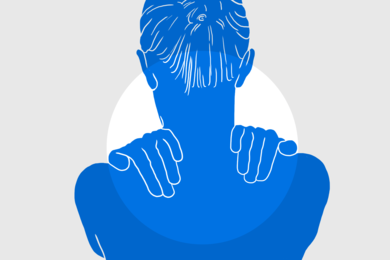Knowledge
Neck Pain

A widespread problem
Neck pain is a widespread problem amongst the adult population. This is not surprising, as the neck (cervical spine) is a complex and delicate structure that is continuously subjected to high stress. Supported by the cervical spine, the head is comparatively heavy and must be able to move freely. Therefore, the bones, joints and connective tissue structures in the area of the cervical spine are subject to wear and tear with increasing age. The processes described are also called 'degenerative' and can be accompanied by chronic pain.
Causes
The neck muscles are under a lot of strain in everyday life, be it due to stress, an improperly set up office workstation, a viral infection, or due to excessive incorrect lying and sitting. Muscular and connective tissue tension leads to painful cramps.
With advancing age, there are also progressive load- and age-related degenerative changes in the area of various structures of the cervical spine. This process, known as spondylosis, can lead to pain in the area of the facet joints, to constriction of nerve roots or even to spinal canal stenosis with spinal cord compression.
Whiplash injury of the cervical spine can occur in the course of a car accident or an unfortunate fall. In addition to neck pain, patients often suffer from headaches, dizziness and hearing/vision problems.
More rarely, neck pain can be attributed to rheumatological, neurological, infectious (meningitis) or oncological (tumor/cancer) diseases.
Symptoms
The pain symptoms depend on the exact cause:
- Shooting, stabbing or burning pain can be a sign of degenerative changes in the facet joints.
- Shooting pain radiating into the arms or numbness in the fingers are warning signals and indicate nerve root irritation.
Persistent, permanent neck pain, electric shooting pain in the arms or numbness in the fingers require prompt specialist examination and treatment planning.
Diagnosis
A detailed anamnesis and a thorough physical examination are the most important factors in making a diagnosis. Imaging procedures (MRI, CT, X-ray) as additional examinations facilitate the diagnosis and help in planning the therapy.
Targeted test injections play a very important role in diagnostics. Under ultrasound or X-ray control, targeted injections with local anaesthetics can be carried out. For example, if such a test injection is made in the area of a facet joint that is questionably painful, it can be examined whether the pain temporarily subsides after the injection. If the complained pain subsides, it can be assumed that the pain originates from the structure in question.
Therapy
The treatment of chronic neck pain is often complex. Careful therapy planning is of great importance and helps to properly coordinate different measures. Sometimes it makes sense to carry out certain therapies in parallel. This can result in certain synergies that improve the chance of successful treatment. Conversely, in many cases it is also advisable to carry out treatment steps separately and not in parallel.
- Physiotherapy
- Co-analgesic medication
- Tricyclic antidepressants
- SSNRI antidepressants
- Antiepileptic drugs
- Treatment with opiates
- For severe uncontrolled pain
- Only under close medical supervision
- Interventional options
- Steroid injection to nerve root
- Pulsed radiofrequency treatment
- Neuromodulation
- Transcutaneous electrical neurostimulation (TENS)
- Spinal cord stimulation (SCS)
- Surgical procedure




















